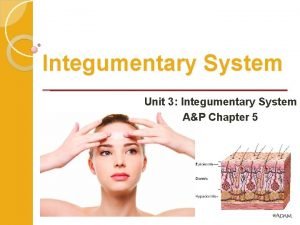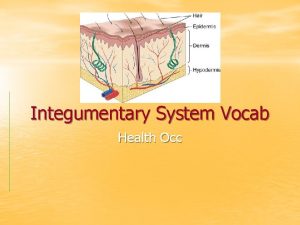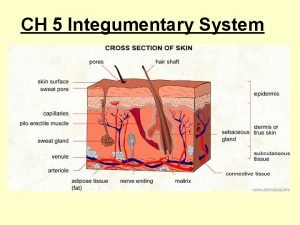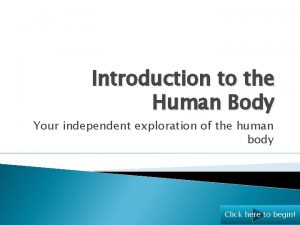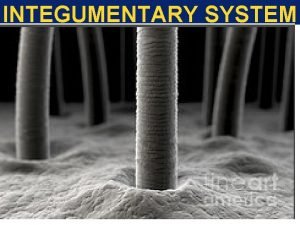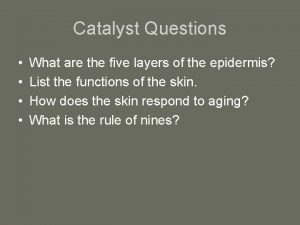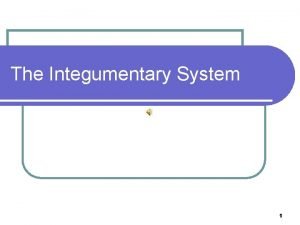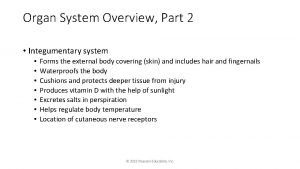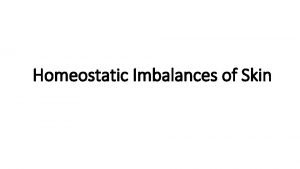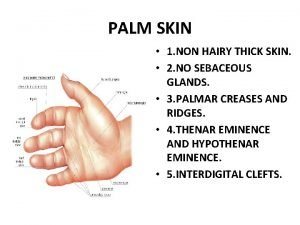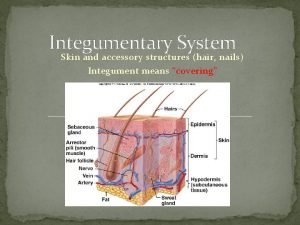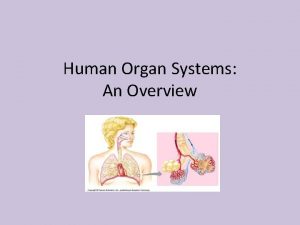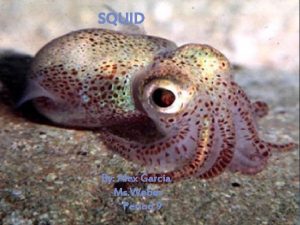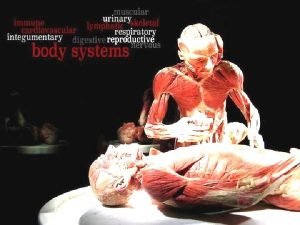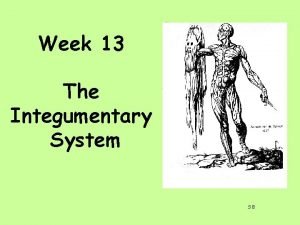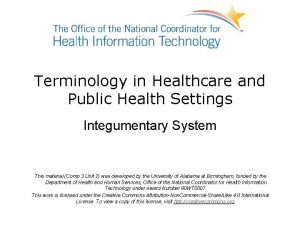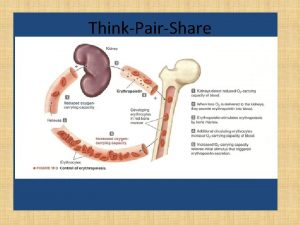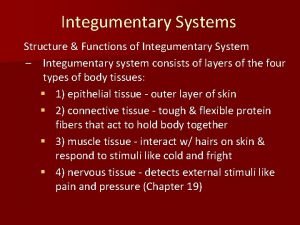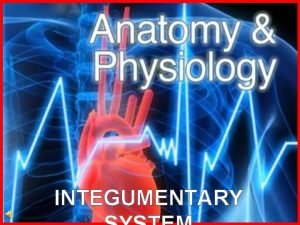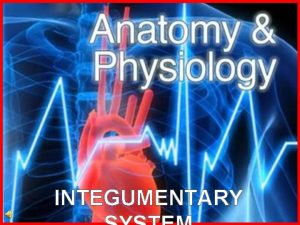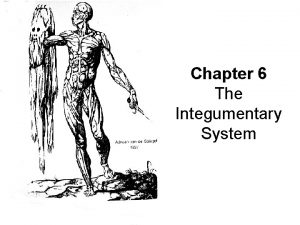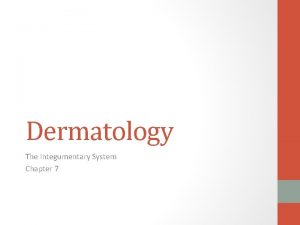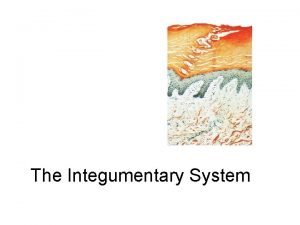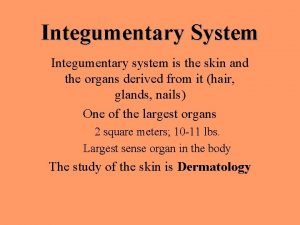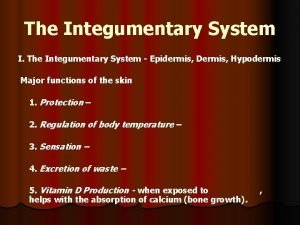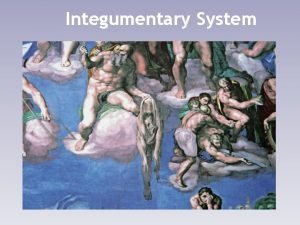Chapter 4 The Integumentary System The Integumentary System








































- Slides: 40

Chapter 4: The Integumentary System

The Integumentary System: �contains the skin & its appendages (hair, nails, skin glands & skin receptors

Skin Facts!!!! - the largest (average size adults is about 1. 6 – 1. 9 m 2 (17 -20 square meters) - thinnest (slightly less than 0. 05 cm (1/50 inch) to 0. 3 cm (1/8 inch) - self-repairing - another name is integument

The skin is one of a group of simple sheetlike structures called membranes – thin, sheet-like structure that may have many important functions in the body – they are: 1. ) cover & protect the body surface 2. ) line body cavities 3. ) cover inner surfaces of hollow organs (dig, repro & resp passageways) 4. ) anchor organs to each other or to bone 5. ) secrete lubricating fluids that reduce friction (heartbeat, lung movement)

2 Major Types of Membranes: 1. ) Epithelial Membrane – composed of epithelial tissue & underlying layer of specialized connective tissue 3 types of epithelial membrane A. ) Cutaneous Membrane – covers body surfaces that are exposed to the external environment – the skin composes about 16% of body wt

B. ) Serous Membrane – lines cavities that are not open to external envir. & covers many of the organs inside these cavities - composed of 2 distinct layers of tissue – 1. ) an epithelial sheet (simple squamous) 2. ) a connective tissue layer - 2 types of serous membrane 1. ) parietal membrane – lines the wall of a cavity 2. )visceral membrane – covers the organ surface

- in the thoracic cavity, serous membrane is called pleura – surrounds a lung & lines the cavity - pleurisy – inflammation of the pleura - there is also pericardium – surrounds the heart - in the abdominal cavity, the serous membrane is called peritoneum – covers the abdominal viscera & lines the cavity - Peritonitis - inflammation of the peritoneum

C. ) Mucous Membrane – lines body surfaces opening directly to the exterior - secretes a thick, slimy material called mucus to keep the membrane moist & soft - mucocutaneous junction – junction where skin & mucous membrane meet

2 Major Membranes cont… 2. ) Connective Membrane – composed exclusively of various types of connective tissue – no epithelial cells are present – only 1 type: - Synovial Membranes – line the spaces between bones & joints - lubricated by synovial fluid

The Skin: - cutaneous membrane composed of: 1. ) Epidermis – outermost & thinnest layer of the skin - thick vs thin skin – only pertain to epidermis Ø most of the body’s skin is thin – 1 or more strata are absent – has hair Ø soles of feet, palms & other areas subject to friction are thick – all 5 strata are present – has fingerprints & footprints

Epidermis is composed of several types of epithelial cells a. ) keratinocytes – 90% of the epidermal cells – are filled w/ keratin – form outer skin b. ) melanocytes – 5% of the epidermal cells – give the skin color c. ) Langerhans cells – work with leukocytes to trigger immune rxns


- Cell layers – Strata – the 5 strata are named for structural or functional characteristics A. ) Stratum Corneum – “horny layer” - most superficial • composed of squamous cells that are dead when they reach the surface • their cytoplasm has been replaced by keratin (keratinization) & their cell membrane is thick & chemically resistant • Desmosomes are present to hold these cells together & strengthen it for wear & tear • Called the barrier area because it prevents H 2 O loss & envir. threats • Certain diseases can cause this strata to thicken beyond normal limits hyperkeratosis – produces thick, dry, scaly skin that is inelastic & causes painful fissures


B. ) Stratum Lucidum – “clear layer” • Keratinocytes are packed together & clear – nuclei are absent & indistinct cell outlines • Cells are filled w/ eleidin (substance that blocks H 2 O loss or penetration) which will become keratin C. ) Stratum Granulosum – “granular layer” • Where keratinization begins • Cells are arranged in a sheet 2 -4 layers deep & filled w/ keratohyalin (staining granules) • Cell degeneration has begun, so lysosomal enzymes are present in cytoplasm & nuclei are absent

D. ) Stratum Spinosum – “spiny layer” • Formed from 8 -10 layers of irregularly shaped cells w/ prominent desmosomes • Cells are rich in RNA so they initiate protein synthesis to make keratin E. ) Stratum Basale – “base layer” • Single layer of columnar cells • Only cells to undergo mitosis – about 10 -12% of all cells in this layer enter mitosis each day these last 2 layers are called Stratum Germinativum (growth layer)

Epidermal Growth & Repair: Takes about 35 days for a new keratinocyte to complete mitosis, differentiation & movement to the surface of the epidermis Can be accelerated by abrasions – continuous abrasions can result in an increase in mitotic activity & shortened turnover time to produce an abnormally thick stratum corneum at the point of friction (a callus)


Dermal-Epidermal Junction – composed of basement membrane, fibrous elements & polysaccharide gel that cements the 2 layers together – functions as a mechanical support & partial barrier - detachment of the 2 layers in large amts could lead to infection & death!!!

2. ) Dermis – or corium – “true skin” – deeper & thicker of the 2 - may exceed 4 mm on soles & palms, thinnest on eyelids & penis - generally thinner on the ventral side & thicker on the dorsal - mechanical strength lies in the dermis, also provides storage for H 2 O & electrolytes contains somatic sensory receptors that detect pain, pressure, touch & temp. also has muscle fibers, hair follicles, sweat & sebaceous glands & blood vessels

Dermal Cell Layers: A. ) Papillary Layer – contains papillae (bumps) made of loose connective tissue & thin collagenous & elastic fibers • Creates the fingerprint & footprint that allows us to grip things B. ) to up Reticular Layer – thicker, w/ more network of fibers • Contains collagenous & elastic fibers – able rebound • Point of attachment for skeletal & smooth muscles - arrector pili muscles – causes hair to stand in goose pimples

Dermal Growth & Repair: � doesn’t continually regenerate & shed – only in healing of wounds � this is when fibroblasts in the dermis quickly reproduce to form dense mass of new connective tissue fibers – if not replaced by normal tissue a scar remains � to have a less noticeable scar, incisions must be made parallel to the Langer’s cleavage lines (pattern formed the dense bundles of white collagenous fibers) � when elastic fibers are stretched too much like in pregnancy or obesity tiny tears occur (stretch marks) that as they heal they lose their color & become silver-white scars



Skin Color: � determined by the amt of melanin deposited in epidermal cells � we all have the same amt of melanocytes scattered throughout the stratum basale – it is the amt of melanin actually produced by these cells that determines the color � melanocytes convert the am. acid tyrosine to melanin using the enzyme tyrosinase– this ability is determined by: A. ) heredity – 4 -6 pairs of genes control the amt of melanin produced - if tyrosinase is absent – albinism results (absence of color in hair, skin & eyes) B. ) exposure to the sun C. ) excess secretion of adrenocorticotropic hormone (ACTH) D. ) increasing age


Skin Functions: 1. ) Protection – 1 st line of defense for the body – protects the body from: A. ) Daily Invasion D. ) Water Loss B. ) Entry of harmful chemicals E. ) Sun’s rays C. ) Tears & Cuts F. ) Pain How does this function work? - Surface Film – produced by mixing residue & secretions from sweat & sebaceous glands with epithelial cells that are being cast off from the epidermis Functions: a. ) antibacterial & antifungal activity d. ) lubrication b. ) hydration of skin surface e. ) toxic agent blockade c. ) Caustic irritant buffering

2. ) Sensation – millions of somatic sensory receptors serve as receivers for the body, keeping it informed of changes in the envir. 3. ) Movement & Growth w/out Injury – skin is supple & elastic 4. ) Excretion – gets rid of H 2 O, urea, ammonia, uric acid to regulate sweat vol. & content 5. ) Vitamin D Production – UV light triggers molecules in the skin to convert to precursors that will produce Vitamin D to be used in biological rxns

6. ) Immunity – Langerhans cells function w/ helper T cells to trigger immune rxns in certain diseases 7. ) Temperature Regulation – done by: a. ) sweat secretion – cools the body by evaporation b. ) blood flows close to the body surface - temperature is detected by the hypothalamus - which will use negative feedback until the homeostatic set point for normal body temp. is reached – usually 37°C

Appendages of the Skin: 1. ) Hair • Areas w/ no hair: lips, soles of the feet, palms of the hands, nipples, & certain regions of the genitalia • Hair follicles dvlp before birth – will be called lanugo (“down”) – is extremely fine & most will be lost before birth • Will be replaced by vellus hair – stronger, fine & less pigmented

• Vellus will be replaced by terminal hair – coarse hair - replaces 80 -90% in males (beard, chest, extremities), not much in females (pubic & axillary areas)

• Hair growth begins when epidermal cells grow down into the dermis to form the follicle – at the base of the follicle the stratum germinativum forms a small, cap-shaped cluster of cells called the germinal matrix – inside this cluster a mound of dermis called papilla brings blood capillaries to matrix - the matrix will undergo mitosis, be pushed upward & keratinized to form hair Parts of the hair: 1. ) Root – hidden part 3. ) Medulla – inner core 2. ) Shaft – visible part 4. ) Cortex – outer portion


2. ) Nails • Formed when epidermal cells over the terminal ends of the fingers & toes fill up w/ keratin & become hard & plate-like • 4 Parts: A. ) Nail Body – visible part B. ) Root – the rest of the nail that lies in a groove & is hidden by a fold of skin called the cuticle C. ) Lunula – “little moon” – nail body nearest the root - crescent shaped white area D. ) Nail Bed – layer of epithelium under the nail – appears pink due to the supply of oxygen


3. ) Skin Glands • Includes 3 kinds: A. ) Sudoriferous Glands – sweat glands – most numerous – classified 2 groups: 1. ) Eccrine Sweat Glands • Most numerous, imp & widespread • Small & distributed over total body surface except for the lips, ear canal, glans penis & nail bed • Produce perspiration (sweat) • Sweat secreted through pores eliminates waste • Maintains constant body temp • Numerous on palms, soles, forehead & upper torso

2. ) Apocrine Sweat Glands • Located in armpits, areola of breast, & pigmented skin around anus • Larger • Enlarge & begin function at puberty • Secretes a thicker, milky secretion – in females it can show cyclic changes linked to menstrual cycle • Odor comes from the contamination of this secretion by skin bacteria

B. ) Sebaceous Glands – oil glands • Secrete oil for hair & skin • Located where hair grows & other small places where it doesn’t (lip, eyelid, etc) • Secrete sebum – contains triglycerides, waxes, fatty acids & cholesterol to produce an antifungal effect • Vary in size – not located on palms or soles • Sebum secretion increases during adolescence when stimulated by increased blood levels of sex hormones • Frequent sebum accumulation enlarges some of the ducts forming white pimples sebum will darken when oxidized to form a blackhead

C. ) Ceruminous Glands – modification of apocrine glands • Ducts open onto free surface of skin in external ear canal, or w/ sebaceous glands into the necks of hair follicles in this area • Secretions mixed with sebaceous glands produces cerumen (earwax) • Protects ear canal skin from dehydration • Can harden & cause blockage which leads to loss of hearing

4. Skin Receptors - 5 types: - Meissner Corpuscles – light touch Pacinian Corpuscles – pressure Free nerve endings – pain Krauses’s end bulbs – cold Others
 Unit 3 integumentary system a&p chapter 5
Unit 3 integumentary system a&p chapter 5 Chapter 6 integumentary system
Chapter 6 integumentary system Chapter 36 skeletal muscular and integumentary systems
Chapter 36 skeletal muscular and integumentary systems Cutaneous membrane
Cutaneous membrane Integumentary system vocabulary
Integumentary system vocabulary Integumentary system pig
Integumentary system pig Pengertian sistem integumen
Pengertian sistem integumen Epidermis layers
Epidermis layers Exercise 7 the integumentary system
Exercise 7 the integumentary system Integumentary system abbreviations
Integumentary system abbreviations Integumentary
Integumentary The integumentary system
The integumentary system Integumentary system physical examination
Integumentary system physical examination Integumentary system analogy
Integumentary system analogy The integumentary system
The integumentary system The integumentary system
The integumentary system Integumentary system components
Integumentary system components Effects of aging on the integumentary system
Effects of aging on the integumentary system Section 36-3 the integumentary system
Section 36-3 the integumentary system Integumentary system
Integumentary system Integumentary system
Integumentary system Skin homeostatic imbalances
Skin homeostatic imbalances Dermis microscope
Dermis microscope 6 functions of the integumentary system
6 functions of the integumentary system Skin cancer
Skin cancer Urinary system facts
Urinary system facts Integumentary system
Integumentary system Integumeny
Integumeny Integumentary system cpt coding guidelines ppt
Integumentary system cpt coding guidelines ppt Contains several layers of polygonal keratinocytes
Contains several layers of polygonal keratinocytes Palmar facia
Palmar facia Nails integumentary system
Nails integumentary system Integumentary system
Integumentary system Excretory and integumentary system
Excretory and integumentary system Squid integumentary system
Squid integumentary system Body systems foldable
Body systems foldable Histology hair
Histology hair How do you pronounce integumentary
How do you pronounce integumentary Integumentary interactions with other systems
Integumentary interactions with other systems Hát kết hợp bộ gõ cơ thể
Hát kết hợp bộ gõ cơ thể Frameset trong html5
Frameset trong html5
